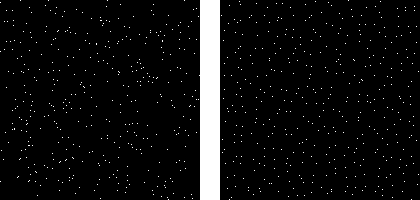The clustering illusion is the human tendency to expect random events to appear more regular or uniform than they are in reality, resulting in the assumption that clusters in the data cannot be caused by chance alone. An important example of this is that the stars in the night sky seem clumped together in some regions, while there are “empty” spots in other regions. The clustering illusion is then simply the tendency to expect that there must be some sort of physical explanation for this (e.g., the stars must be physically grouped in space), since it “doesn’t seem truly random”. In reality, however, the position of the stars is random, and it is our expectation of the variability that is wrong. The image on the left below shows an example of a truly random star field. The image on the right is a random star field that is too uniform to be realistic, but that might be closer to what a human would draw if you would ask him or her to create such a star field manually. In the example on the right, each single star is placed randomly in its own 20 × 20 pixel square, producing a more uniform, but unrealistic, effect.
 Truly random star field (left) and overly uniform star field (right)
Truly random star field (left) and overly uniform star field (right)Simulated Geiger Counter
A second example is radioactive decay, which is really the quintessential example of randomness, since each decay is an independent event that is not influenced by earlier decays, and that is unpredictable on a very fundamental (quantum mechanical) level. Clicking the Start simulation button below starts a simulated Geiger counter, which produces an audible “tick” for each simulated decay event. The simulated decay rate is two events per second. The groups of events that seem to be present, have no physical meaning.
counts: 0
I am aware that a browser with JavaScript is not ideal for this kind of time-related work, but it is good enough for this demonstration. It does not work very well anymore if you switch to another tab, since the JavaScript in a background tab is given lower priority. In Simulating a Geiger Counter, I explain how this simulation works.
Add new comment